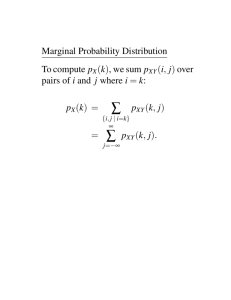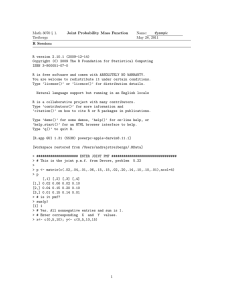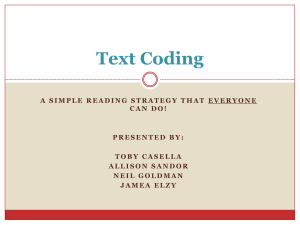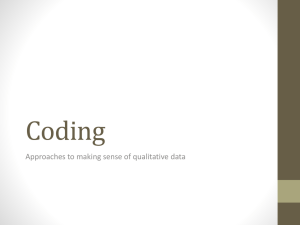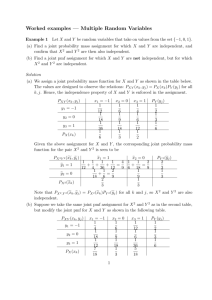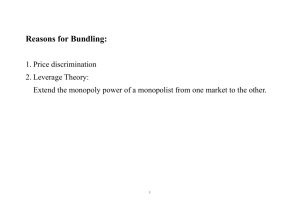Chapter1
advertisement
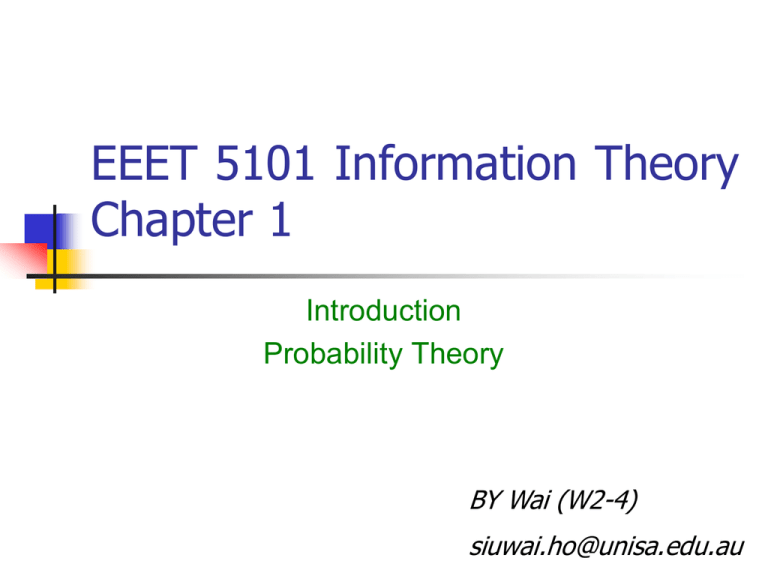
EEET 5101 Information Theory
Chapter 1
Introduction
Probability Theory
BY Wai (W2-4)
siuwai.ho@unisa.edu.au
Basic Course Information
Lecturers:
Dr Siu Wai Ho, W2-4, Mawson Lakes
Dr Badri Vellambi Ravisankar, W1-22, Mawson Lakes
Dr Roy Timo, W1-7, Mawson Lakes
Office Hour: Tue 2:00-5:00pm (starting from 27/7/2010)
Class workload:
Homework Assignment 25%
Mid-term 25%
Final 50%
Textbook: T. M. Cover and J. M. Thomas, Elements of Information
Theory, 2nd, Wiley-Interscience, 2006.
2
Basic Course Information
References:
OTHER RELEVANT TEXTS (Library):
1.Information Theory and Network Coding by Raymond Yeung
2.Information Theory: Coding Theorems for Discrete Memoryless Systems by Imre
Csiszar and Janos Korner.
OTHER RELEVANT TEXTS (Online):
3.Probability, Random Processes, and Ergodic Properties by Robert Gray
4.Introduction to Statistical Signal Processing Robert Gray and L. Davisson
5.Entropy and Information Theory by Robert Gray http://ee.stanford.edu/~gray/
3
The Beginning of Information Theory
In 1948, Claude E. Shannon published his paper “A Mathematical
Theory of Communication” in the Bell Systems Technical Journal.
He introduced two fundamental concepts about “information”:
Information can be measured by entropy
Information to be transmitted is digital
Information
Source
Transmitter
Receiver
Signal
Message
Received
Signal
Noise Source
Destination
Message
4
The Beginning of Information Theory
In the same paper, he has answered two fundamental questions in
communication theory:
What is the ultimate data compression ?
Source
u = u1 … un
Encoder
x1 … xm
Decoder
v = v1 … vn
Receiver
How to minimize the compression rate m/n with Pr{u v} = 0.
What is the ultimate transmission rate of communication?
k {1,…,2n}
Source
Encoder
x1 … xm
Channel
y1 … y m
Decoder
k’
Receiver
How to maximize the transmission rate n/m with Pr{k k’} 0.
5
The Idea of Channel Capacity
Example [MacKay 2003]: Suppose we are now provided a noisy channel
Channel
x
y
We test it 10000 times and find the following statistics
Pr{y=0|x=0} = Pr{y=1|x=1} = 0.9; Pr{y=0|x=1} = Pr{y=1|x=0} = 0.1
The occurrence of difference is independent of the previous use
0
0.9
0
0.1
1
1
0.9
Suppose we want to send a message: s = 0 0 1 0 1 1 0
The error probability = 1 – Pr{no error} = 1 – 0.97 0.5217
How can we get a smaller error probability?
6
The Idea of Channel Capacity
Method 1: Repetition codes
[R3] To replace the source message by 0 000; 1 111
s
0
0
1
0
1
1
0
t
000
000
111
000
111
111
000
n
000
001
000
000
101
000
000
r=tn
000
001
111
000
010
111
000
0
0
1
0
0
1
0
s’
t: transmitted symbols
n: noise
r: received symbols
Majority vote
at the receiver
The original bit error probability Pb : 0.1.
The new Pb : = 3 0.9 0.12 + 0.13 = 0.028
Rate of a code
The number of bits transmitted 1
The number of channel use
3
bit error probability 0 rate 0 ??
7
The Idea of Channel Capacity
Method 1: Repetition codes
pb 0 rate 0
8
The Idea of Channel Capacity
Method 2: Hamming codes
[(7,4) Hamming Code] group 4 bits into s. E.g., s = 0 0 1 0
Here t = GTs = 0 0 1 0 1 1 1, where
1 0 0 0
0 1 0 0
G
0 0 1 0
0 0 0 1
1 0 1
1 1 0
1 1 1
0 1 1
9
The Idea of Channel Capacity
Method 2: Hamming codes
Is the search of a good code an everlasting job?
Where is the destination?
10
The Idea of Channel Capacity
Information theory tells us the fundamental limits.
Shannon’ s
Channel Coding
Theorem
It is impossible to design a code with coding rate and error
probability on the right side of the line.
11
Intersections with other Fields
Information theory shows
the fundamental limits in
different communication
systems
It also provides insights
on how to achieve these
limits
It also intersects
other fields
[Cover and Thomas
2006]
12
Content in this course
2)
Information Measures and Divergence:
2a) Entropy, Mutual Information and Kullback-Leibler Divergence
-Definitions, chain rules, relations
2b) Basic Lemmas & Inequalities:
-Data Processing Inequality, Fano’s Inequality.
3) Asymptotic Equipartition Property (AEP) for iid Random
Processes:
3a) Weak Law of Large Numbers
3b) AEP as a consequence of the Weak Law of Large Numbers
3c) Tail event bounding:
-Markov, Chebychev and Chernoff bounds
3d) Types and Typicality
-Strong and weak typicality
3e) The lossless source coding theorem
13
Content in this course
4)
5)
The AEP for Non-iid Random Processes:
4a) Random Processes with memory
-Markov processes, stationarity and ergodicity
4b) Entropy Rate
4c) The lossless source coding theorem
Lossy Compression:
5a) Motivation
5b) Rate-distortion (RD) theory for DMSs (Coding and Converse theorems).
5c) Computation of the RD function (numerical and analytical)
Source
u = u1 … un
Encoder
x1 … xm
Decoder
v = v1 … vn
Receiver
How to minimize the compression rate m/n with u and v satisfying certain
distortion criteria.
14
Content in this course
6)
Reliable Communication over Noisy Channels:
6a) Discrete memoryless channels
-Codes, rates, redundancy and reliable communication
6b) Shannon’s channel coding theorem and its converse
6c) Computation of channel capacity (numerical and analytical)
6d) Joint source-channel coding and the principle of separation
6e) Dualities between channel capacity and rate-distortion theory
6f) Extensions of Shannon’s capacity to channels with memory (if time
permits)
15
Content in this course
7) Lossy Source Coding and Channel Coding with SideInformation:
8)
7a) Rate Distortion with Side Information
-Joint and conditional rate-distortion theory, Wyner-Ziv coding, extended
Shannon lower bound, numerical computation
7b) Channel Capacity with Side Information
7c) Dualities
Introduction to Multi-User Information Theory (If time permits):
Possible topics: lossless and lossy distributed source coding, multiple access
channels, broadcast channels, interference channels, multiple descriptions,
successive refinement of information, and the failure of source-channel
separation.
16
Prerequisites – Probability Theory
Let X be a discrete random variable taking values from the alphabet
The probability distribution of X is denoted by pX = {pX(x), x X}, where
pX(x) means the probability that X = x.
pX(x) 0
x pX(x) = 1
Let SX be the support of X, i.e. SX = {x X: p(x) > 0}.
Example :
Let X be the outcome of a dice
Let = {1, 2, 3, 4, 5, 6, 7, 8, 9, …} equal to all positive integers.
In this case, is a countably infinite alphabet
SX = {1, 2, 3, 4, 5, 6} which is a finite alphabet
If the dice is fair, then pX(1) = pX(2) = = pX(6) = 1/6.
If is a subset of real numbers, e.g., = [0, 1], is a continuous alphabet
17
and X is a continuous random variable
Prerequisites – Probability Theory
Let X and Y be random variable taking values from the alphabet X and Y,
respectively
The joint probability distribution of X and Y is denoted by pXY and
pXY(xy) means the probability that X = x and Y = y
pX(x), pY(y), pXY(xy) p(x), p(y), p(xy) when there is no ambiguity.
pXY(x) 0
X
PY|X
Y
xy pXY(x) = 1
Marginal distributions: pX(x) = y pXY(xy) and pY(y) = x pXY(xy)
Conditional probability: for pX(x) > 0, pY|X(y|x) = pXY(xy)/ pX(x) which
denotes the probability that Y = y given the conditional that X = x
Consider a function f: X Y
If X is a random variable, f(X) is also random. Let Y = f(X).
E.g., X is the outcome of a fair dice and f(X) = (X – 3.5)2
What is pXY?
18
Expectation and Variance
The expectation of X is given by E[X] = x pX(x) x
The variance of X is given by E[(X – E[X])2] = E[X2] – (E[X])2
The expected value of f(X) is E[f(X)] = x pX(x) f(x)
The expected value of k(X, Y) is E[k(X, Y)] = xy pXY(xy) k(x,y)
We can take the expectation on only Y, i.e.,
EY[k(X, Y)] = y pY(y) k(X,y) which is still a random variable
E.g., Suppose some real-valued functions f, g, k and l are given.
What is E[f(X, g(Y), k(X,Y))l(Y)]?
xy pXY(xy) f(x, g(y), k(x,y))l(y) which gives a real value
What is EY[f(X, g(Y), k(X,Y)]l(Y)?
y pY(y) f(X, g(y), k(X,y))l(y) which is still a random variable.
Usually, this can be done only if X and Y are independent.
19
Conditional Independent
Two r.v. X and Y are independent if p(xy) = p(x)p(y) x, y
For r.v. X, Y and Z, X and Z are independent conditioning on Y,
denoted by X Z | Y if
p(xyz)p(y) = p(xy)p(yz) x, y, z
----- (1)
Assume p(y) > 0,
p(x, z|y) = p(x|y)p(z|y) x, y, z
----- (2)
If (1) is true, then (2) is also true given p(y) > 0
If p(y) = 0, p(x, z|y) may be undefined for a given p(x, y, z).
Regardless whether p(y) = 0 for some y, (1) is a sufficient
condition to test X Z | Y
p(xy) = p(x)p(y) is also called pairwise independent
20
Mutual and Pairwise Independent
Mutual Indep. : p(x1, x2, …, xn) = p(x1)p(x2) p(xn)
Mutual Independent Pairwise Independent
Suppose we have i, j s.t. i, j [1, n] and i j
Let a= [1, n] \ {i, j}
p X X X ( x1, x2 ,..., xn )
p X ( x1) p X ( x2 ) p X ( xn )
1 2
n
1
2
n
xi : i a
xi : i a
p
Xi X j
( xi , x j ) p X ( x1) p X ( x2 ) p X ( xi ) p X ( x j ) p X ( xn )
1
2
i
j
n
x1
x2
xn
p X i ( xi ) p X j ( x j )
Pairwise Independent Mutual Independent
21
Mutual and Pairwise Independent
Example : Z = X Y and Pr{X=0} = Pr{X=1} = Pr{Y=0} = Pr{Y=1} = 0.5
Pr{Z=0} = Pr{X=0}Pr{Y=0} + Pr{X=1}Pr{Y=1} = 0.5
Pr{Z=1} = 0.5
Pr{X=0, Y=0} = 0.25 = Pr{X=0}Pr{Y=0}
Pr{X=0, Z=1} = 0.25 = Pr{X=0}Pr{Z=1}
Pr{Y=1, Z=1} = 0.25 = Pr{Y=1}Pr{Z=1} ……..
So X, Y and Z are pairwise Independent
However, Pr{X=0, Y=0, Z=0} = Pr{X=0}Pr{Y=0} = 0.25
Pr{X=0}Pr{Y=0}Pr{Z=0} = 0.125
X, Y and Z are not mutually Independent but pairwise Independent
22



